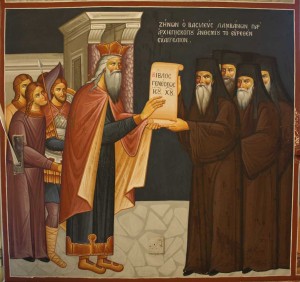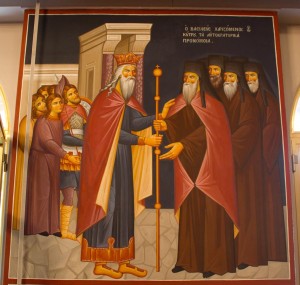Thanksgiving in Nicosia and “baston imperial”
November 24th, 2011
Lynne is spending the day cooking a big, Thanksgiving meal. Twelve of us will sit down at 7:00 PM to eat together: three Americans, three British, an undergraduate student from Paris, a doctoral student from Poland, and an assortment of Greek Cypriots. Some do not have much of an idea of how or why we celebrate this American holiday.
Lynne tried unsuccessfully to find a turkey, so she decided to just cook some chickens. But when Vathoula heard about it, she said, “No problem.” Yesterday she brought a turkey to CAARI. From the looks of this never-frozen bird, it was recently a farm animal used to roaming around. The breast is much smaller than the turkeys we buy in stores in the USA. And the wing muscles are much more developed.
But the stoves here are small, and we had trouble figuring out how to get the bird into the oven. We could not use a roasting rack, so we had to figure out what to do. Google to the rescue. Search option: “How can I roast a turkey without a roasting rack?”
http://www.chow.com/food-news/65593/how-to-roast-your-turkey-without-a-roasting-rack/

Wall painting in the Archbishopric, showing Barnabas appearing to Anthemios in a vision, and Anthemios discovering the saint's body under a carob tree.
While Lynne cooks, I am tracking down information about the special, royal privileges granted to the archbishop of Cyprus—what most Greek Cypriots will describe if you ask them what they know about Barnabas. The problem is that the earliest mention I have of these privileges comes from the 1500s.
The artwork that I see in local churches depicts Emperor Zeno granting royal privileges to the Cypriot Archbishop Anthemios in the late fifth century. However, the sixth century text (Latin title Laudatio Barnabae apostoli) that describes Barnabas appearing to Anthemios in a vision, and Anthemios recovering the body of Barnabas (with a handwritten copy of Matthew on his chest), and Anthemios appearing before Zeno and giving the copy of Matthew to the emperor, makes no mention whatsoever that the Emperor granted royal privileges to Anthemios. He granted a lot of money to build a church in honor of Barnabas, but that was all.
The tradition of the archbishop being allowed to wear special robes, and to carry a
royal scepter, and to sign his name in cinnabar on documents—a tradition so central to religion and politics in Cyprus—comes from a much later time period. Using a massive database of ancient Greek texts, I have been busily tracking down the earliest references to these privileges. Although the database goes through the 1500s, however, it contains not a single reference to the archbishop of Cyprus having royal privileges. Actually, no text after Laudatio Barnabae even mentions Archbishop Anthemios. He seems to have fallen into a black hole.
The earliest existing texts mentioning privileges for the Archbishop come from non-Greek authors. Etienne de Lusignan (ca. 1570) mentions that the archbishop was allowed to wear red. Florio Bustron (a bit earlier in the 16th century) mentions the imperial scepter: “baston
imperiale, con il pomo in cima, et il capello con la croce rossa di supra” (I can’t read Italian. Can anyone translate this quotation for me?). So far, the earliest Greek text mentioning royal privileges that I have found was written by Archimandrite Kyprianos in Venice in 1788.
Suffice it to say, a number of Greek Cypriots will not be pleased to read about this aspect of my research. The deeper I dig, the more surprises I find. Traditions—gotta love them.
Posted in Uncategorized | Comments Off on Thanksgiving in Nicosia and “baston imperial”



